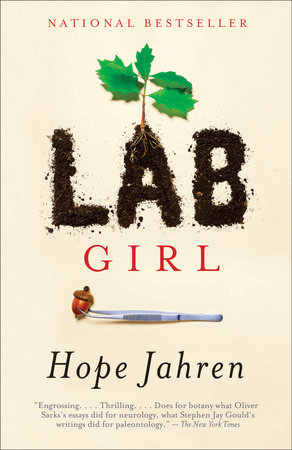Reading Group Center
- Home •
- Books by Category •
- Imprints •
- News •
- Videos •
- Media Center •
- Reading Group Center
A Day in the Garden with Hope Jahren, Author of Lab Girl
Hope Jahren is an award-winning geobiologist and esteemed professor. She received her PhD from UC Berkeley and is the winner of three Fulbright Awards. Impressed yet? That’s not all. Hope is also the author of Lab Girl, the warm and vivid memoir about her life as a scientist and a woman. It’s a book that entertains as much as it teaches and we’re so excited that it’s finally available in paperback! Get to know Hope a little better in this exclusive essay.
At dinner parties, when people ask me what I do for a living, I tell them, “I am a scientist. I study how plants work.” I should give them the better answer, which is this: “I am the most overeducated gardener that you will ever meet.”
I get the opportunity to talk about gardening pretty often. I used to attend big professional meetings and say things like “the glucose moieties within phenlyglucazone from Triticum aestivum differs from that attached to carbons-3 through -6 by at least nine percent” to the other sixty or so people in the world who care, about eight of whom were probably listening. But my life has changed thanks to Lab Girl, when I discovered that only by writing down the untold story of how we do science, can I finally understand why we did it in the first place.
That’s the beauty of being a scientist: I’m thirty years in and still learning new things.
As for gardening, I’ve actually got five gardens, but they are small. I make each garden inside in a Plexiglas box of dirt, walled on all six sides. These boxes are 3 x 4 x 2 feet in size—about as big as a small bookshelf. They are high-tech: I can control almost everything that happens inside of them. I can fill them with soil of various fertility, add any imaginable mixture of gases, raise or lower the temperature, shine bright or dim lights, add driving rain or sprinkled dew, blow a gentle breeze, a hurricane wind, or turn the fans off entirely to yield deathly calm. I pick the plant, the earth, the day length, the climate—even the sky—for my five hundred leafy soldiers, plant the seeds, start the clock, and watch what happens.
You’d need an escort to visit my garden: My laboratory is behind double-locked doors, mostly to keep stray students from wandering in, lost and looking for the registrar. And anyway, a casual onlooker isn’t likely to give them nearly enough credit—for they aren’t just gardens, they are actual, honest-to-God time machines.
Would you like to experience the apex of the last ice age? How about the moment of dinosaur extinction? Or even when the very first life evolved? I can make it happen, with two important caveats. First, I’ll be using other scientists’ best guesses about what things were like back then; and second, you have to be a plant. Let me bury you in soil, put you in the chamber, and long before your first leaf, you’ll have absolutely no evidence that it’s not eighteen thousand, sixty-five million, or four billion years ago, respectively.
Sound like fun? It is. It really is. Take it from me, there’s nothing in the world better than spending the day in the garden.
—Hope Jahren


